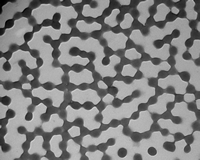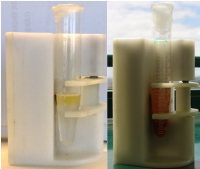Bioseparation Engineering
The Bioseparation Engineering Laboratory (BEL) aims at the design and development of novel purification processes in order to intensify and optimize the downstream processing of proteins and biopharmaceuticals, with special emphasis on monoclonal antibodies (mAbs). Several alternatives to the currently established downstream processing platforms of recombinant proteins are being explored, with main focus on aqueous two-phase extraction, nano-magnetic separation and monolithic chromatography, from a nano-scale to industrial scale. Additionally, tailor-made synthetic ligands are being used aiming to improve protein purification, stability and function.
Research Projects
Aqueous two-phase systems (ATPS) for biopharmaceuticals purification
The feasibility of using aqueous two-phase extraction as a general platform for the purification of biopharmaceuticals, especially of mAbs produced by hybridoma and Chinese hamster ovary cells is being evaluated. Different type of systems, including PEG-salt, PEG-dextran and others, including smart polymers and new liquid polymeric supports, are being screened and evaluated in order to recover the target bioproduct with high yield and purity. To further increase selectivity and improve process throughput, affinity ligands are being incorporated within these systems. Efficient models are being developed in order to predict protein partition in ATPS, contributing for a better understanding of the mechanisms responsible for partitioning of biomolecules. and the parameters governing partition.
Bio-inspired affinity polymer systems for antibody recognition
The main goal of this project is the synthesis and application of bio-inspired affinity polymer systems. Stimuli-responsive or “smart” polymers, such as poly(N-isopropylacrylamide) (PNIPAM) constitute an interesting alternative for developing affinity polymeric materials with a broad range of biotechnological applications. Conjugation of PNIPAM with Protein L-mimic affinity ligands is used as a strategy to develop novel bio-inspired affinity polymer systems for antibody recognition. Microgel polymer (nano)particles will be screened as heterobifunctional macroligands for the molecular recognition/purification of antibodies and genetically related molecules. Synthesis and covalent engraftment of ligands into different functionalised polymers is being optimised. Evaluation of functional (biologic mimic) activity and efficiency of macroligands will be addressed.
Nano-magnetic separation of biopharmaceuticals
Current research is focused on the development of magnetic nanoparticles (MNPs) suitable for the purification of mAbs. MNPs coated with different polymeric materials and tailor-made synthetic ligands are being produced aiming to improve stability and selectivity of the magnetic separation process. Furthermore, magnetic aqueous two-phase systems (MATPS) represent a viable alternative format to chromatography, and will also be addressed.
Monolithic chromatography for integration of cell separation and antibody purification
Current research is focused on designing and developing novel affinity and mixed-mode ligands for the purification of mAbs, with particular focus on phenyl boronate derivatives. The immobilization of the ligands to the surface of supramacroporous monoliths (cryogels) will allow the integration of both clarification and capture in just one step, and thus the capture of mAbs directly from cell culture media without any cell removal step upstream.
Highthrouput bioseparation platforms
The main goal is to develop an integrated lab-on-a-chip microfluidic device for antibodies purification from a complex medium, using ATPS in a microfluidic platform, as an effective tool to accelerate bioprocess design in a cost-effective manner. In addition, the use of microfluidic systems allows for scaling-out therefore considerably easing translation to large-scale production.
Stability assessment during downstream processing
To ensure that the purified antibody retains its biological and pharmacological activity, the integrity of the native conformation of the polypeptide chain must be preserved throughout the selected purification train. Since changes on 3-D structure of the mAb can increase the immunogenicity of the final product, this project aims to monitor any alteration on its secondary, tertiary and quaternary structure, using spectroscopic techniques, like fluorescence and circular dichroism.
Research Projects:


